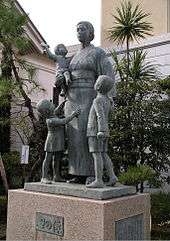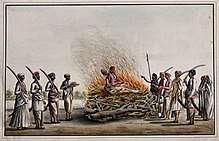Widow
A widow is a woman whose spouse has died and a widower is a man whose spouse has died. The treatment of widows and widowers around the world varies.
Relationships (Outline) |
|---|
|
Endings |
Terminology
A widow is a woman whose spouse has died, while a widower is a man whose spouse has died. The state of having lost one's spouse to death is termed

widowhood.[1] These terms are not applied to a divorcé(e) following the death of an ex-spouse. An archaic term for a widow is "relict,"[2] and this word can sometimes be found on older gravestones.
The term widowhood can be used for either sex, at least according to some dictionaries,[3][4] but the word widowerhood is also listed in some dictionaries.[5][6] Occasionally, the word viduity is used.[7] The adjective for either sex is widowed.[8][9]
Economic position


In societies where the husband is the sole provider, his death can leave his family destitute. The tendency for women generally to outlive men can compound this, as can men in many societies marrying women younger than themselves. In some patriarchal societies, widows may maintain economic independence. A woman would carry on her spouse's business and be accorded certain rights, such as entering guilds. More recently, widows of political figures have been among the first women elected to high office in many countries, such as Corazón Aquino or Isabel Martínez de Perón.
In 19th-century Britain, widows had greater opportunity for social mobility than in many other societies. Along with the ability to ascend socio-economically, widows—who were "presumably celibate"—were much more able (and likely) to challenge conventional sexual behaviour than married women in their society.[10]
In some parts of Europe, including Russia, Czechoslovakia, Greece, Italy and Spain, widows used to wear black for the rest of their lives to signify their mourning, a practice that has since died out. Many immigrants from these cultures to the United States as recently as the 1970s have loosened this strict standard of dress to only two years of black garments. However, Orthodox Christian immigrants may wear lifelong black in the United States to signify their widowhood and devotion to their deceased husband.
In other cultures, however, widowhood customs are stricter. Often, women are required to remarry within the family of their late husband after a period of mourning. With the rise of HIV/AIDS levels of infection across the globe, rituals to which women are subjected in order to be "cleansed" or accepted into her new husband's home make her susceptible to the psychological adversities that may be involved as well as imposing health risks.
It may be necessary for a woman to comply with the social customs of her area because her fiscal stature depends on it, but this custom is also often abused by others as a way to keep money within the deceased spouse's family.[11] It is also uncommon for widows to challenge their treatment because they are often "unaware of their rights under the modern law…because of their low status, and lack of education or legal representation.".[12] Unequal benefits and treatment generally received by widows compared to those received by widowers globally has spurred an interest in the issue by human rights activists.[12] During the HIV pandemic, which particularly hit gay communities, companions of deceased men had little recourse in estate court against the deceased family. Not yet able to have been legally married the term widower was not considered socially acceptable. This situation was usually blessed with an added stigma being attached to the surviving man.
As of 2004, women in United States who were "widowed at younger ages are at greatest risk for economic hardship." Similarly, married women who are in a financially unstable household are more likely to become widows "because of the strong relationship between mortality [of the male head] and wealth [of the household]."[11] In underdeveloped and developing areas of the world, conditions for widows continue to be much more severe. However, the United Nations Convention on the Elimination of All Forms of Discrimination against Women ("now ratified by 135 countries"), while slow, is working on proposals which will make certain types of discrimination and treatment of widows (such as violence and withholding property rights) illegal in the countries that have joined CEDAW.[12]
In the United States, Social Security offers a Survivor's Benefit to qualified individuals once for a loss through their 50th birthday after which a second marriage may be considered when applying for benefits. The maximum still remains the same but here the survivor has options between accessing their earned benefits or one of their qualifying late spouses at chosen intervals to maximize the increased benefits for delaying a filing (i.e. at age 63 claim husband one's reduced benefit, then husband two's full amount at 67 and your own enhanced benefit at 68).
Effects of widowhood
The phenomenon that refers to the increased mortality rate after the death of a spouse is called the widowhood effect.. It is "strongest during the first three months after a spouse's death, when they had a 66-percent increased chance of dying".[13] Most widows and widowers suffer from this effect during the first 3 months of their spouse's death, however they can also suffer from this effect later on in their life for much longer than 3 months. There remains controversy over whether women or men have worse effects from becoming widowed, and studies have attempted to make their case for which sex is worse off, while other studies try to show that there are no true differences based on sex, and other factors are responsible for any differences.[14]
While it is disputed as to whether sex plays a part in the intensity of grief, sex often influences how an individual's lifestyle changes after a spouse's death. Research has shown that the difference falls in the burden of care, expectations, and how they react after the spouse's death. For example, women often carry more of an emotional burden than men and are less willing to go through the death of another spouse.[15] After being widowed, however, men and women can react very differently and frequently have a change in lifestyle. Women tend to miss their husbands more if he died suddenly; men, on the other hand, tend to miss their wives more if she died after suffering a long, terminal illness.[16] In addition, both men and women have been observed to experience lifestyle habit changes after the death of a spouse. Both sexes tend to have a harder time looking after themselves without their spouse to help, though these changes may differ based on the sex of the widow and the role the spouse played in their life.[16]
The older spouses grow, the more aware they are of being alone due to the death of their husband or wife. This negatively impacts the mental as well as physical well being in both men and women.[17]
Superstitious beliefs on widows
In parts of Africa, such as Kenya, widows are viewed as impure and need to be 'cleansed'. This often requires having sex with someone. Those refusing to be cleansed risk getting beaten by superstitious villagers, who may also harm the woman's children. It is argued that this notion arose from the idea that if a husband dies, the woman may have performed witchcraft against him.
In parts of India and Nepal a woman is often accused of causing her husband's death and is not allowed to look at another person as her gaze is considered bad luck.[18]
Those likely to be accused and killed as witches, such as in Papua New Guinea, are often widows.[19]
In the folklore of Chiloé of southern Chile, widows and black cats are important elements that are needed when hunting for the treasure of the carbunclo.[20][21]
Classic and contemporary social customs
Widow inheritence
Widow inheritance (also known as bride inheritance) is a cultural and social practice whereby a widow is required to marry a male relative of her late husband, often his brother.
India

Until the early 19th century it was considered honourable in some parts of India for a Hindu widow to immolate herself on her late husband's funeral pyre. This custom, called sati, was outlawed in 1827 in British India and again in 1987 in independent India by the Sati Prevention Act, which made it illegal to support, glorify or attempt to commit sati. Support of sati, including coercing or forcing someone to commit sati, can be punished by death sentence or life imprisonment, while glorifying sati is punishable with one to seven years in prison.
Even if they did not commit suicide, Hindu widows were traditionally prohibited from remarrying. The Hindu Widows' Remarriage Act, 1856, enacted in response to the campaign of the reformer Pandit Ishwar Chandra Vidyasagar,[22] legalized widow remarriage and provided legal safeguards against loss of certain forms of inheritance for remarrying a Hindu widow,[23] though, under the Act, the widow forsook any inheritance due her from her deceased husband.[24]
The status of widowhood for Hindus was accompanied by a body symbolism:[25]
- The widow's head was shaved as part of her mourning.
- She could no longer wear a red dot (sindur) on her forehead and was forbidden to wear wedding jewellery.
- She was expected to walk barefoot.
But now, these customs are disappearing.[26]
Korea
Social stigma in Joseon Korea required that widows remain unmarried after their husbands' death. In 1477, Seongjong of Joseon enacted the Widow Remarriage Law, which strengthened pre-existing social constraints by barring the sons of widows who remarried from holding public office.[27] In 1489, Seongjong condemned a woman of the royal clan, Yi Guji, when it was discovered that she had cohabited with her slave after being widowed. More than 40 members of her household were arrested and her lover was tortured to death.[28]
Fiji
The people of Fiji practised widow-strangling. When Fijians adopted Christianity, widow-strangling was abandoned.[29]
See also
- Estate planning
- International Widows Day
- Orphan
- Remarriage
- Single parent
- Sati
- Widow conservation
- Saint Bridget of Sweden
References
- "Definition of WIDOWHOOD". Merriam-Webster. Retrieved 2016-03-18.
- "Relict definition and meaning - Collins English Dictionary". www.collinsdictionary.com. Retrieved 25 May 2020.
- "Widowhood definition and meaning - Collins English Dictionary". www.collinsdictionary.com. Retrieved 2 May 2017.
- "widowhood - definition of widowhood in English - Oxford Dictionaries". Oxford Dictionaries - English. Retrieved 2 May 2017.
- "Widowerhood definition and meaning - Collins English Dictionary". www.collinsdictionary.com. Retrieved 2 May 2017.
- "Definition of WIDOWERHOOD". www.merriam-webster.com. Retrieved 2 May 2017.
- "Definition of 'viduity'". Collins English Dictionary. Retrieved 2019-05-24.
- "Widowed definition and meaning - Collins English Dictionary". www.collinsdictionary.com. Retrieved 2 May 2017.
- "widowed Meaning in the Cambridge English Dictionary". dictionary.cambridge.org. Retrieved 2 May 2017.
- Behrendt, Stephen C. "Women without Men: Barbara Hofland and the Economics of Widowhood." Eighteenth Century Fiction 17.3 (2005): 481-508. Academic Search Complete. EBSCO. Web. 14 Sept. 2010.
- "Imagine...." Widows' Rights International. Web. 14 Sep 2010. <http://www.widowsrights.org/index.htm>.
- Owen, Margaret. A World of Widows. Illustrated. Atlantic Highlands, NJ: Zed Books, 1996. 181-183. eBook.
- "'Widowhood effect' strongest during first three months". Reuters. 14 November 2016. Retrieved 2 May 2017.
- Trivedi, J., Sareen, H., & Dhyani, M. (2009). Psychological Aspects of Widowhood and Divorce. Mens Sana Monogr Mens Sana Monographs, 7(1), 37. doi:10.4103/0973-1229.40648
- Stahl, Sarah T.; Schulz, Richard (2014). "The effect of widowhood on husbands' and wives' physical activity: the cardiovascular health study". Journal of Behavioral Medicine. 37 (4): 806–817. doi:10.1007/s10865-013-9532-7. PMC 3932151. PMID 23975417. Retrieved 2016-04-28 – via Gale Academic OneFile.
- Wilcox, Sara; Evenson, Kelly R.; Aragaki, Aaron; Wassertheil-Smoller, Sylvia; Mouton, Charles P.; Loevinger, Barbara Lee (2003). "The effects of widowhood on physical and mental health, health behaviors, and health outcomes: The Women's Health Initiative". Health Psychology. 22 (5): 513–22. doi:10.1037/0278-6133.22.5.513. PMID 14570535.
- Utz, Reidy, Carr, Nesse, & Wortman, 2004 as Cited in Mumtaz 71
- "These Kenyan widows are fighting against sexual 'cleansing'". pri.org. 23 October 2018. Retrieved 7 November 2018.
- "The gruesome fate of "witches" in Papua New Guinea". economist.com. 13 July 2017. Retrieved 23 July 2017.
- Quintana Mansilla, Bernardo (1972). "El Carbunco". Chiloé mitológico (in Spanish).
- Winkler, Lawrence (2015). Stories of the Southern Sea. First Choice Books. p. 54. ISBN 978-0-9947663-8-0.
- Forbes, Geraldine (1999). Women in modern India. Cambridge University Press. p. 23. ISBN 978-0-521-65377-0. Retrieved 8 November 2018.
- Peers, Douglas M. (2006). India under colonial rule: 1700-1885. Pearson Education. pp. 52–53. ISBN 978-0-582-31738-3. Retrieved 8 November 2018.
- Carroll, Lucy (2008). "Law, Custom, and Statutory Social Reform: The Hindu Widows' Remarriage Act of 1856". In Sumit Sarkar; Tanika Sarkar (eds.). Women and social reform in modern India: a reader. Indiana University Press. p. 80. ISBN 978-0-253-22049-3. Retrieved 8 November 2018.
- Olson, Carl. The Many Colors of Hinduism. Rutgers University Press.
- "On India's back roads, sati revered". Los Angeles Times. 10 December 2006.
- Uhn, Cho (1999). "The Invention of Chaste Motherhood: A Feminist Reading of the Remarriage Ban in the Chosun Era". Asian Journal of Women's Studies. 5 (3): 45–63. doi:10.1080/12259276.1999.11665854.
- 성종실록 (成宗實錄) [Veritable Records of Seongjong] (in Korean). 226. 1499.
- "Odd Faiths in Fiji Isles". nytimes.com. The New York Times. 8 February 1891.
| Wikimedia Commons has media related to Widows. |
| Wikiquote has quotations related to: Widow |
| Look up widow in Wiktionary, the free dictionary. |